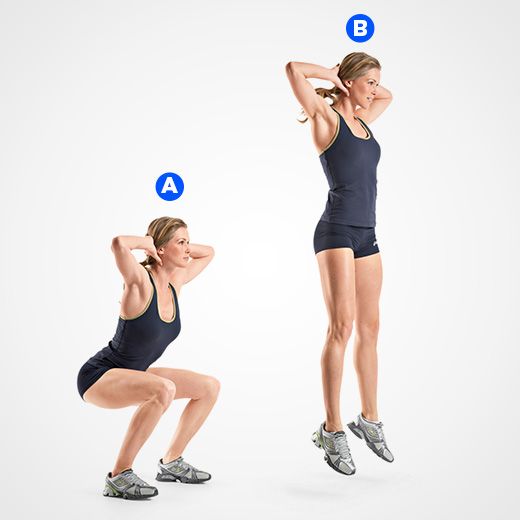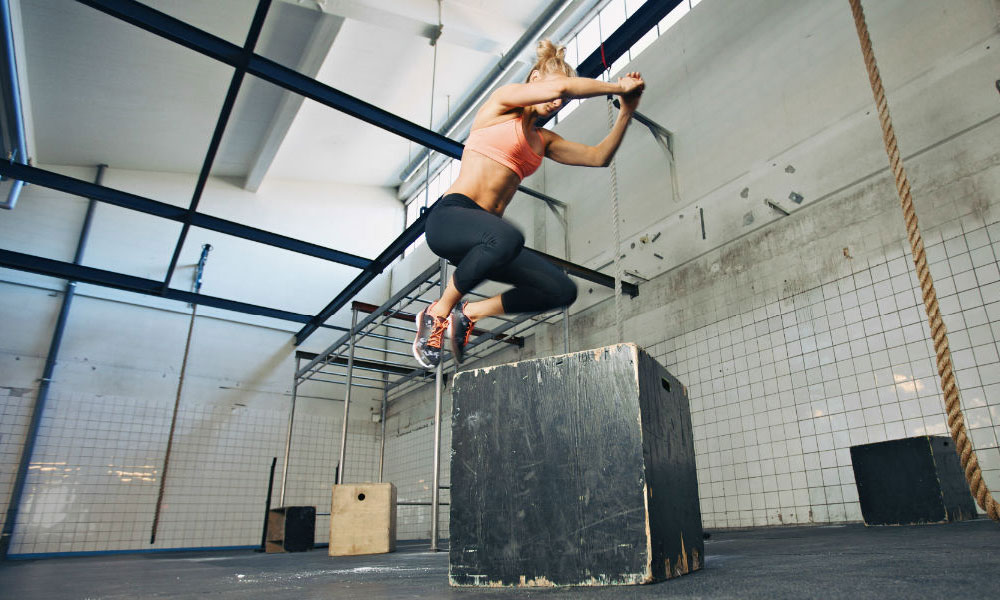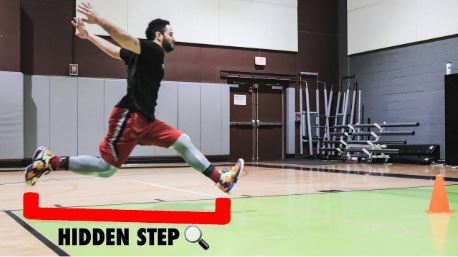Our bodies are fascinating pieces of “machinery” — although jumping comes naturally and appears simple in theory, the actual science behind the motion is deeply complex and rooted in specific biomechanics that can make or break optimal performance.
But, we’ve never shied away from the complex. Jumping is still 100% a skill that can be optimized and improved over time, so getting in enough practice can yield significant improvements.
The only thing is that it has to be the right kind of practice. You’ll need to implement different types of training to truly develop change, and that’s what this blog is here for: to dive into the nuances of jump training and what you can do to achieve your highest vertical possible.
So let’s jump right into it, shall we?
How to Measure Vertical Jump
Okay, not right into it.
Before looking at the details on how to improve your jump height, you’ll first want to know how to measure your current jump height. (Otherwise, you might not even realize if you’re making improvements, and what’s the fun in that?)
There are several methods for assessing the height of your vertical jumps. Granted, some methods are more accurate than others, but it can be handy to have a variety of ways to assess your jump height.
Let’s review what the most common methods look like.
Measuring Jump Height by Reach
Using your arm reach is a quick and dirty way to evaluate your vertical jump height since it doesn’t require much equipment. Plus, it’s super easy to execute.
You first start out by measuring the standing reach of the athlete (which is just the maximum height of their arm fully extended above them). Then, all they have to do is jump next to a wall and mark the highest point of their jump (most people use some tape or a chalk line for a clear visual). From there, just take the athlete’s standing reach and subtract it from their maximum jump height, and boom: you’ve got a pretty solid estimate of their vertical jump height.

Many professional sports combines and sports facilities will take this simple test one step further by utilizing a piece of equipment known as a Vertec Jump Tester, which you can see in the picture here. This creates more of a specific target for the athlete to reach for while also measuring the actual height of their jump.
The biggest downside to measuring an athlete’s reach, however, is that it isn’t an exact science, so you’re more likely to yield inaccurate results. If an athlete happens to under- or over-exceed their reach target, it can skew the measurements of their jump height and cause inconsistency in their assessment.
So what’s the most accurate method, then?
Measuring Jump Height with Specific Data
Data.
If you’re inclined to understand the specifics of your jump capabilities, using a force plate and its pinpoint data is the way to go.
Force plates are the golden standard for reliability and validity of measuring vertical jumps, since they can calculate your jump height from the moment you leave the ground until you land back down on the plate. Using contact times and estimated flight time will ultimately yield more accurate results compared to the other jump tests. Plus, using a force plate also provides insight into additional information like your force production or shock absorption during your jumps. (It’s super neat.)
Types of Vertical Jump Tests
Now, even if you’re using a force plate to collect the most accurate jump data possible, you’ll still need to consider other variables, like the type of jump you’re measuring, or how the test itself is performed.
There’s significant variety in the types of jump tests you can perform. And interestingly enough, each variation can provide different bits of insight into your jumps.

For example, testing with squat jumps strictly measures the output of power your legs can produce when you push off the ground without any additional loading or energy absorption. (This is different from usual vertical jump tests where you get a running start into your jump, but more on that later.)
In order to perform a squat jump test, start with your hands on your hips while you’re in your lowest squat position; then, you jump. That’s basically all there is to the test. This measurement will provide you with an idea of how much force your legs can generate on their own. You can think of this like you’re testing the compression of a spring; the faster you can compress it, the more force it’ll produce, and that force is what you’re working to measure through squat jump tests.
Conversely, practicing countermovement jumps will help your body practice that same eccentric loading while also recruiting that additional loading from the running start just before your jump. (If you aren’t familiar with this kind of jump, it’s when you start in an upright position, bend at your knees and hips, then spring into a vertical jump. This replicates the motion when you take your final step just before launching off the ground.) If you use your arms while executing these jumps, your body will replicate the same kind of jumping mechanics as it would experience in-game. Plus, this habit will get you to practice leveraging your upper body and arm swing to add to those vertical forces that’ll improve your jump height over time.
Finally, you could also work with the assessment known as the Reactive Strength Index (RSI). This evaluates an athlete’s ability to eccentrically, isometrically, and concentrically load with speed. Or, in simpler terms, it’ll measure how well your legs can handle load in various positions throughout the jump sequence. The RSI will provide insight into an athlete’s explosive capabilities, and it can typically be performed with a variety of different exercises like standing repeated hops or doing a drop jump off a box.
So there’s clearly plenty of options to measure your jumps… but what actually makes your jumps higher and better??
We’re glad you asked.
What Makes You Jump Higher
So now that you know how to assess your current jump height, let’s review what elements have to come together to achieve that vertical action.
Jumping is 100% a learned skill that will improve with proper training — and that’s not just something coaches will say to keep you motivated. The more you practice your actual jumping, the more your body grows accustomed to those specific movement biomechanics. In fact, vertical jumps can serve as a direct measurement for your lower-leg power and coordination.
When you look at the training programs for most high-level jumpers, you’ll see that a majority of their programs involve some form of jumping practice. Practicing the skill repeatedly will develop the most effective motor pattern for jumping and train the muscles for optimal positioning, firing, and functionality. More specifically, repeated practice helps to improve your nervous system through muscular coordination, improved motor learning, and myelination of motor neurons (leading to better nerve signaling and faster muscular response).
Of course, achieving a better vertical jump isn’t just chalked up to getting enough practice; there are certain specific movements that can enhance your jumping skills…
You’ve probably heard of a nifty thing known as triple extension (but even if you haven’t, we’ll break it down for you anyway).

Triple extension is when the three main joints of your lower extremities — your hip, knee, and ankle joints — all extend simultaneously. (Technically, foot extension is called plantarflexion, but you get the idea.) In order for all three joints to fully extend, your major leg muscle groups must contract at the same time, and that’s where a lot of your jumping power comes from.
Energy originates at the initial extension of your hip and is quickly transferred down your leg through triple extension, and that power is what creates the maximal push off the ground when you launch into your jumps. In fact, when performing vertical jump max effort tests, researchers have found that the maximal power output during triple extension was 6 times higher than the maximal power generated from ankle plantarflexion alone. That’s a huge difference!
And that’s key to remember: power is a large determinant of your vertical jump height. It’s not the only factor, since your strength and speed are also important components, but they won’t get you nearly the same results for vertical height without proper power generation.
So, how do you optimize your power generation to reach new heights? Let’s find out.
How to Train for a Higher Vertical Jump
Now, before you get too amped up, it’s important to note: training for an improved vertical jump doesn’t necessarily come easy. It’s by no means impossible, but there are a lot of factors that contribute to maximal vertical height, so be diligent and take your time to process and implement all the following information.
You probably won’t notice any results right away, but trust us, you’ll definitely start to see some changes over time when you implement training that addresses more intricate aspects of your performance. (And that’s partly why measuring is important — these changes happen over time, and having data to refer to can be invaluable when it comes to motivation and perspective.)
So let’s get started, shall we?
Stretch Reflex
This is one of the most powerful reflexes in the human body. Your stretch reflex encapsulates the reaction your muscles have when they’re exposed to external forces.
It does this by placing loading forces on your muscles, which consequently increases the neuromotor signals to your brain to generate a reactive force in response. Which all sounds kind of complicated, but it’s basically a way of saying that your body responds to external forces and adapts its reaction to counteract the load placed on your muscles. For example, whenever you land a jump, your legs don’t collapse under you — your muscles recognize the impact forces and signal necessary muscle contraction to help absorb the shock of landing. (How neat are our bodies??)
Training your stretch reflex is vital for proper shock absorption, and you’ve got to implement plenty of strength and plyometric training to get there.
We’ll get to that specifically in a little bit; let’s review one more small (but important) piece of the puzzle that’ll make the world of a difference in achieving that new vertical height.
Golgi Tendon Organ Reflex
Okay, let’s start out with the obvious: explaining what the heck a golgi tendon organ (GTO) is. This odd-sounding term is used to describe the nerve receptors that help your muscles respond properly to external forces.
These receptors are located in the tendons found at both ends of a muscle, and their job is to detect when a muscle is placed under new forces. Once they recognize a change in muscle tension or contraction, they’ll send signals to the muscle to make sure it reacts appropriately to the loading forces (i.e., preventing the muscles from contracting when forces are too high to tolerate). If you need some frame of reference, you can think of it this way: if you try to lift something that’s too heavy, your arms will give out. That’s a perfect example of when your GTO is signaling your body that the load is too much to manage and could potentially cause injury.

If you’re more of a visual learner, take a look at this graph for a better idea. To provide a bit of context, the more energy an athlete can initially absorb upon impact, the higher force they can produce in response (meaning a more powerful push-off for that vertical jump). This graph shows the disparity between an athlete who’s trained their stretch reflex and GTO (blue line) versus an athlete who hasn’t (red line). The primary downward slope represents their ability to manage eccentric loading (preparation to jump), and the upward slope indicates the concentric power generated from that energy absorption (actually jumping). As you can see here, the athlete with stretch-reflex and GTO-reflex training was much more capable of efficiently absorbing and reusing energy for the most optimal jump height possible.
Common Program Exercises
Now here’s where we address that strength and plyometric training.
Because strength training is an important aspect of improving your jumps, many vertical jump programs are heavily dependent on weight rooms. However, it’s important to remember that strength isn’t the most important focus for your training; make sure that a majority of your training is more central to the movement techniques specific to vertical jumping. (If you find that more than 50% of your current program is heavy, slow-weighted exercises, it’s time to start shopping for a new training plan.)
While we can’t give you specific, tailored advice on the program perfect for you (without actually knowing you, that is), there are a number of exercises that you’ll find in a majority of effective programs.
For example, most of these programs will include strength-based exercises like the following:
- Deadlifts
- Back Squats
- Front Squats
- ¼ Squat + Calf-Raise Combo
- Olympic Lifts (typically Power Cleans)
- Bulgarian Split Squats / Pistol Squats
- Barbell Hip Thrusts
- Kettlebell Swings

Of course, these aren’t the only options, but a combination of these workouts will help address both posterior and anterior strength in the legs (and the entire leg, which is perfect for that triple extension). Plus, these exercises will get you working in positions that mimic the direction of force and motor patterns of vertical jumping.
And, to cover all your bases, the most effective programs will also include plyometric exercises like the following:
- Bounding
- Pogo Hops
- Depth Jumps (various heights)
- Vertical Medicine Ball Throws
- Speed Tuck Jumps
- Ankle Hops with Dorsiflexion
- Sprints
- Triple Jumps
- Band-Assisted Jumps (provides increased overtraining at higher speeds)
- Box Jumps
- Single-Leg Jumps / Drop Jumps
- Seated Box Jumps
Just like the strength exercises, these plyos are optimal for getting direct practice with the motor patterns of jumping. This is especially important in plyos, since this is where you build up your explosive power for the best launch off the ground.

One thing to keep in mind, however, is that you should only practice these plyo exercises two or three times a week. Many programs neglect to include enough time for an athlete to recover, which is especially important with such high-intensity loads of plyos. Younger or less-trained athletes have to focus on progressively building up their tolerance to high-intensity loads over time. (Just like how newer runners don’t jump straight into running a marathon on day one.) You’ll have to build upon that initial foundation of tolerance so your body can gradually adapt to every new increase in intensity and loading.
With high intensity training like vertical jump training, it’s imperative that your program incorporates weeks of deloading (recovery) in the plan. That means decreased plyometrics and significantly decreased weight loads to ensure that you don’t undo all your hard work by overtraining or sustaining an injury.
Form Tips for That Extra Boost
There are a few specific areas to examine when observing the mechanics and technique of a 2-footed jump setup… so let’s review each bit in succession and understand why they’re all vital pieces of setting up the most optimal jump.
First is the approach speed leading into your jump. The increased speed of your approach will determine how much force is absorbed and then created in your jump. That being said, a faster approach speed doesn’t necessarily mean better — an athlete can’t be going at 100% sprint speed and expect to have proper control during their eccentric loading phase. So it’s super important to monitor your speed and be aware of the maximum velocity your body can handle. Establishing sufficient control is where that jump practice, strength exercise, and plyometrics will kick in.
Second up, we have the penultimate step (or your second to last step before the jump), which is a key portion leading up to your jump. The longer your penultimate step is, the more velocity and force you generate just before landing. That’s why it’s so key to understand your body’s threshold for absorbing and controlling maximal forces. In the image here, notice that the athlete’s arms are set back, the chest is up, and the body is prepared to generate force upwards.

From there, also be sure to pay attention to your block foot, as this is the foot that translates all those horizontal forces into vertical ones. Although your body will do this naturally to some extent, keeping your head up and your chest upright (but slightly angled forward) will help that power switch over to vertical momentum.
Now, with all these moments occurring one after another, your body will have built up quite a bit of force, so you’ll want to be sure that you’re in an optimal position to actually absorb all of that energy. To do this, try to descend to the squat position as quickly as possible from the moment your block foot hits the ground to the moment you reach maximal knee and hip flexion (otherwise when you’re squatted at your lowest point). The faster you can descend, the more your muscles can absorb the forces and generate enough return for your jump. Be sure you actively think about pulling yourself down to this low point; if you’re simply falling into the position due to gravity, you’re limiting your potential energy return, so be intentional and direct about your descent.
And there you have it — four basic tips to optimize your form just moments before achieving your record height for vertical jumping.
Jump to It!
Always remember: jumping higher is a learned skill! With enough practice and the proper knowledge of form and training technique, you’ll notice marked improvements in the efficiency and power of your future vertical jumps.
If you have any further questions about how to increase your vertical jump, feel free to contact our team. Our sports performance physical therapists are capable of conducting full jump analyses and creating custom jump training programs (and we’re also here to answer any further questions you may have about what you read here in this blog).
But, in the meantime, get that practice on. You just might be reaching new heights before you know it.
Resources:
- Smith, J., & Clark, J. (2014). Vertical foundations: the physiology, biomechanics and techniques of explosive vertical jumping. Berkeley, CA: Just Fly Sports.
- Bobbert, M., Huijing, P., & Schenau, G. V. I. (1985). Instantaneous torque-angular velocity relationships during jumping. Journal of Biomechanics, 18(7), 553. doi: 10.1016/0021-9290(85)90828-0
- Dietz, C., & Peterson, B. (2012). Triphasic training: a systematic approach to elite speed and explosive strength performance. Hudson, WI: Bye Dietz Sport Enterprise.

